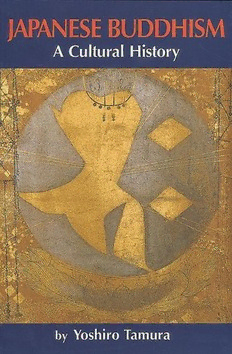
Japanese Buddhism: A Cultural History PDF
Preview Japanese Buddhism: A Cultural History
JAPANESE BUDDHISM JAPANESE BUDDHISM A Cultural History by Yoshiro Tamura translated by Jeffrey Hunter KOSEI PUBLISHING CO. Tokyo The contents of this book were originally published in Japanese by Kosei Publishing Go. in the January-December 1967 issues of the monthly magazine Yakuskin, under the series title “Hyakuman Nin no Bukkyö-shi” (A History of Japanese Buddhism for a Million Readers). The series was published in book form by Kadokawa Shoten in 1969 under the title Mhon Bukkyö-shi Nyümon (An Introductory History of Japanese Buddhism). Shown on the front and back covers is the frontispiece and the beginning of the text of chapter 14 of the Lotus Sutra, “A Happy Life,” from the Heikenö/cyö, a historic set of thirty-three scrolls of copied sutras. The Siddham ideogram on a disk represents Shakyamuni, the historical Bud dha. The set was dedicated by Taira no Kiyomori and his clan in 1164 to the deity of Itsukushima Shrine in what is now Hiroshima Prefecture. Designated a National Treasure of Japan. Owned by Itsukushima Shrine. Photograph courtesy of the Nara National Museum. Cover design by NOBU. The text of this book is set in Monotype Bas- kerville with a computer version of Optima for display. First English edition, 2000 Published by Kosei Publishing Go., 2-7-1 Wada, Suginami-ku, Tokyo 166-8535, Japan. Copyright © 1967, 1969 by Yoshiro Tamura, 2000 by Kosei Publishing Co.; all rights reserved. Printed in Japan. ISBN 4-333-01684-3 LCC Card No. applied for Contents Preface 7 Editorial Note 9 1. Early Japan and the Arrival of Buddhism • 13 2. The Birth of the Japanese Nation and the Ascent of Buddhism • 23 3. The Buddhist Adaptation • 35 4. The Japanese Response • 49 5. Heian Buddhism: Saichö and Kükai • 59 6. Tendai Philosophy: The Ideal and the Real *73 7. Pure Land Buddhism • 79 8. The Founders of Kamakura Buddhism • 91 9. Key Features of Kamakura Buddhism • 103 10. The Triumph of the Secular • 113 11. The Subjugation of Buddhism • 127 12. Challenges to the Old Order • 139 13. Religious Reform Movements • 149 14. Christianity and the Buddhist Renaissance • 159 5 6 CONTENTS 15. The New Buddhism and the First Wave of New Religions • 169 16. The Second Wave of New Religions • 183 17. The New Religions and Mainstream Buddhism Before and During World War II • 197 18. Postwar New Religions and the Future of Buddhism • 207 Index 217 Preface JAPAN IS OFTEN DESCRIBED as having a hybrid culture. But this does not mean that disparate cultured elements were simply em braced indiscriminately; rather, they were vigorously assimilated and skillfully made over into Japanese cultural artifacts. The same thing happened with Buddhism: It was absorbed into Japanese culture and reconstituted as Japanese Buddhism. Thus it is impos sible to separate Japan’s Buddhism from the nation’s cultural ma trix, or to explicate the one without understanding the other. Japanese scholars have produced some fine histories of Japanese Buddhism. Most of these works, however, confine themselves to historical facts and make use only of purely Buddhist sources. Few discuss such literary classics as the Manÿôshü, Genji monogatari, Hö- jöki, and Tsurezuregusa, though it is impossible to grasp the distinc tive features of Japanese Buddhism without some knowledge of these works. Conversely, Japan’s literary scholars tend to disregard or show only a cursory interest in Buddhism. This, too, precludes true understanding of Japanese literature. Some literary works are so deeply steeped in Buddhism that they can jusdy be considered Buddhist writings, but they are ignored by Buddhist scholars, while literary scholars discuss Japanese literature as though Buddhism did not exist. This blinkered approach distorts both fields of schol arship. Traditionally, historians have applied historical methodology to 7 8 PREFACE the study of Japanese Buddhism. That has become the mainstream approach, one that focuses on what we might call the outer his tory. I have chosen to approach the subject from the inside, as it were, by writing an intellectual history of Japanese Buddhism. This has meant examining Japanese Buddhism in the context of literary and intellectual trends, as well as of other religions. For this reason I have devoted a great deal of space to literary works and to other religions—Shintö, folk religion, Christianity, new reli gions—while omitting some of the details of stricdy Buddhist de velopments. Since this book represents an approach to Japanese culture and thought, nothing would make me happier than to have it read as an introduction to Japan’s cultural and intellectual history. Editorial Note IN THIS BOOK all Japanese personal names follow the customary Japanese name order: family name followed by given name. As a rule, premodern figures are referred to by given name on second and subsequent mentions, whereas modern figures are referred to by surname. The transition from premodern to modern is the Meiji era (1868-1912). In the case of transitional figures, the name used tends to reflect the time at which the person was most active or with which he or she is most closely identified. Macrons, indicating sustained vowels, are used where appropri ate with all Japanese names and terms except in the case of the cities of Tokyo (Tokyo), Kyoto (Kyoto), and Osaka (Osaka). A modified orthography that does not include diacritical marks is used for Sanskrit names and terms. The Wade-Giles system is fol lowed in the transliteration of Chinese names and terms. Every effort has been made to adhere to the Western method of reckoning people’s age. (The traditional Japanese method includes the year of birth, so that on one’s first birthday one is considered to be two years old, not one year old.) Some anomalies may re main, however, since it has proved impossible to verify all the ages mentioned in the original Japanese text. 9
